Section 1: Agency overview and resources
1.1 Strategic direction
The Australian Office of Financial Management (AOFM) is responsible for the management of Australian Government debt and financial assets. It issues Treasury Bonds, Treasury Indexed Bonds and Treasury Notes, manages the Government's cash balances and invests in high quality financial assets including residential mortgage-backed securities, term deposits, money market instruments and short-dated State government bonds.
For some years the Government has issued Treasury Bonds in order to maintain liquid and efficient Bond and Bond futures markets, reflecting the important role that these markets play in the Australian financial system. Since February 2009 debt issuance has been required to fund the Budget. Treasury Bonds continue to be the main instrument in the AOFM's issuance strategy to meet the Government's funding needs. The use of Treasury Indexed Bonds facilitates the diversification of the investor base by tapping into additional sources of investor demand.
Treasury Notes and short-term assets are used to manage the Government's within-year financing task.
The AOFM makes direct investment in high quality, AAA rated residential mortgage-backed securities to support competition in residential mortgage lending and to support lending to small business. Subject to market conditions, in 2011-12 the AOFM will continue to consider proposals for investment in residential mortgage-backed securities in accordance with the terms of the program. Under the Competitive and Sustainable Banking Package the AOFM has a mandate to invest up to $20 billion. This will allow the AOFM to continue to support smaller lenders, and to accelerate the development of a range of residential mortgage-backed securities.
In the 2011-12 Budget, the AOFM will receive additional funding to implement the trading of Commonwealth Government Securities (CGS) on a securities exchange. Retail trading of CGS will facilitate broader access to the Government's debt products and may facilitate further development of the corporate bond market in Australia.
1.2 Agency resource statement
Table 1.1 shows the total resources from all sources. The table summarises how resources will be applied by outcome and by administered and departmental classification.
Table 1.1: Australian Office of Financial Management resource statement — Budget
estimates for 2011-12 as at Budget May 2011
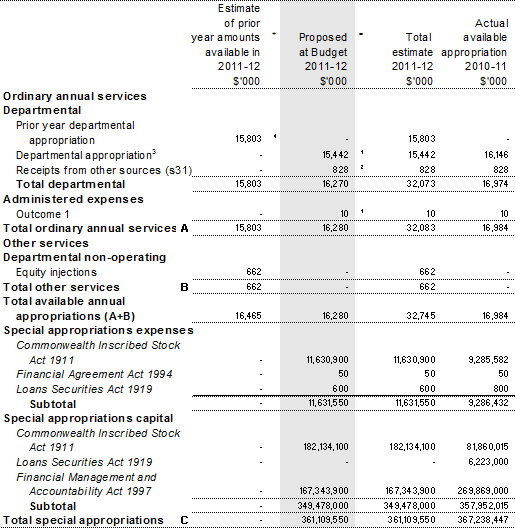
Table 1.1: Australian Office of Financial Management resource statement — Budget
estimates for 2011-12 as at Budget May 2011 (continued)
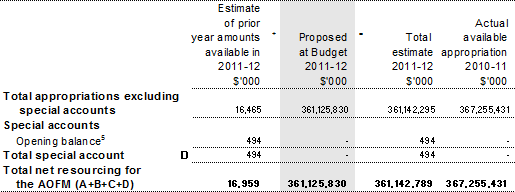
1. Appropriation Bill (No. 1) 2011-12.
2. Receipts received under s31 of the Financial Management and Accountability Act 1997.
3. Includes $3.0 million in 2011-12 for the departmental capital budget (refer to Table 3.2.5 for further details).
4. Estimated adjusted balance carried forward from previous year for annual appropriations.
5. Estimated opening balance for special accounts (refer to Table 3.1.2 for further details).
1.3 Budget measures
Budget measures relating to the AOFM are detailed in Budget Paper No. 2, Budget Measures 2011-12 and are summarised below.
Table 1.2: Australian Office of Financial Management 2011-12 Budget measures
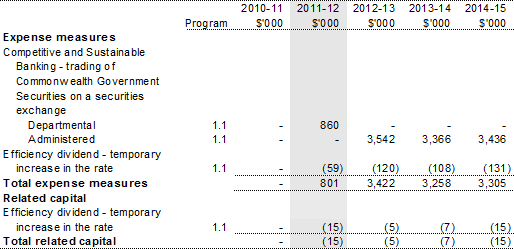
Prepared on a government finance statistics (fiscal) basis.
Section 2: Outcomes and planned performance
2.1 Outcomes and performance information
Government outcomes are the intended results, impacts or consequences of actions by the Government on the Australian community. Commonwealth programs are the primary vehicle by which government agencies achieve the intended results of their outcome statements. Agencies are required to identify the programs which contribute to government outcomes over the budget and forward years.
The AOFM's outcome is described below, specifying the strategy, program, objective, deliverables and key performance indicators used to assess and monitor the performance of the AOFM.
Outcome 1: The advancement of macroeconomic growth and stability, and the effective operation of financial markets, through issuing debt, investing in financial assets and managing debt, investments and cash for the Australian Government
Outcome 1 strategy
The AOFM's activities include debt issuance, cash management, investment, portfolio management, compliance, financial reporting, debt administration, promotional activities with investors, monitoring of market conditions and liaison with market participants.
Currently debt issuance is directed to meeting the Government's Budget funding needs. Both Treasury Bonds and Treasury Indexed Bonds will be issued to meet this objective. Issuance will remain flexible to achieve an appropriate balance between meeting investor demand, and managing refinancing risk and the costs of the debt portfolio.
The within-year cash management task results from differences in the timing of receipts and payments in the Official Public Account. In managing the Government's cash requirements, the AOFM will continue to issue Treasury Notes and make short-term term deposits with the Reserve Bank of Australia and invest in money market instruments and fixed interest investments. In 2010-11 the AOFM established Global Master Repurchase Agreements with a number of the members of its investment facility dealing panel in order to enter into repurchase agreements on its fixed interest investments.
In December 2010, the Government further extended its program of investing in residential mortgage-backed securities by $4 billion as part of the Competitive and Sustainable Banking Package.
Over the course of 2011-12 the AOFM will work to implement the retail trading of CGS on a securities exchange. This will entail the selection and appointment of one or more securities exchanges and the selection and appointment of a stock registry.
The AOFM's financial assets and financial liabilities are managed in accordance with legislative requirements, delegations and directions from the Treasurer and instructions from the Secretary to the Treasury and the AOFM Chief Executive. This governance framework ensures that activities and financial risks are managed in a tightly controlled manner.
Outcome expense statement
Table 2.1 provides an overview of the total expenses for Outcome 1.
Table 2.1: Budgeted expenses for Outcome 1
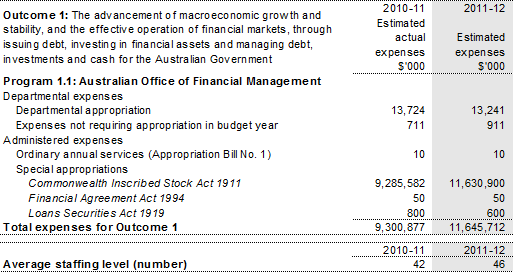
Contributions to Outcome 1
Program 1.1: Australian Office of Financial Management
Program objective
Achievement of the Government's financing task in a cost-effective manner, subject to acceptable risk, maintain liquidity in the Treasury Bond and Treasury Bond futures markets, and facilitate a return to a competitive residential mortgage-backed securities market.
Program expenses
With the increased level of debt on the AOFM's administered balance sheet, debt servicing costs arising from the issuance will also rise.
Table 2.2: Program expenses
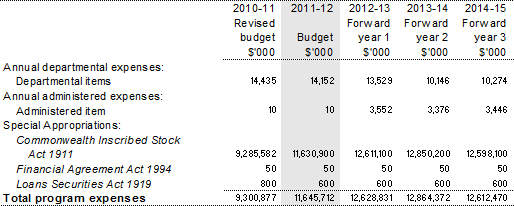
Program deliverables
The AOFM has the following key deliverables:
- issue Treasury Bonds, Treasury Indexed Bonds and Treasury Notes;
- invest in residential mortgage-backed securities;
- manage the Official Public Account balance; and
- manage the risks of the debt portfolio.
Program key performance indicators
The AOFM has the following key performance indicators:
- debt issuance — volume and efficiency of issuance,
- monitoring issue yields against secondary market yields,
- monitoring the range of accepted bids, and
- monitoring the tender bids ratio; and
- efficient management of the Government's cash balances,
- maintaining the 91 day moving average of the Government's cash balances within operational limits and within the Ministerial limit throughout the year, and
- using the overdraft facility with the Reserve Bank of Australia to cover unexpected events only; and
- promote investors' take up of Commonwealth Government Securities by intermediaries and investors,
- building relations through the conduct of investor meetings and conference presentations; and
- investment in residential mortgage-backed securities,
- the volume of investment undertaken, the extent of participation by other investors and the quality of the securities issued; and
- operating within legal and policy limits,
- compliance with legislative and policy limits.
Section 3: Explanatory tables and budgeted financial statements
Section 3 presents explanatory tables and budgeted financial statements which provide a comprehensive snapshot of agency finances for the 2011-12 budget year. It explains how budget plans are incorporated into the financial statements and provides further details of the reconciliation between appropriations and program expenses, movements in administered funds, special accounts and government Indigenous expenditure.
3.1 Explanatory tables
3.1.1 Movement of administered funds between years
The AOFM has not moved any administered funds between years.
3.1.2 Special accounts
Special accounts provide a means to set aside and record amounts used for specified purposes. Special accounts can be created by a Finance Minister's Determination under the Financial Management and Accountability Act 1997 or under separate enabling legislation. Table 3.1.2 shows the expected additions (receipts) and reductions (payments) for each account used by the AOFM.
Table 3.1.2: Estimates of special account cash flows and balances

Until July 1990, the Australian Government borrowed on behalf of the State and Northern Territory Governments and allocated a portion of its Treasury Bond raisings to those governments to fund the redemption of previous allocations of bonds. Until 1986, the Australian Government also borrowed on behalf of State and Northern Territory Governments to raise new borrowings. In addition, there are outstanding balances of various loans raised by the State Governments.
The annual funding to meet the redemption of debt allocated to the States and the Northern Territory is governed by the Financial Agreement Act 1994, which requires the Australian Government to establish and maintain the Debt Retirement Reserve Trust Account for the States and the Northern Territory. Monies standing to the credit of a State or the Northern Territory are applied by the Australian Government in connection with the repurchase and repayment of the debt of that State or the Northern Territory.
Only perpetual debt with no fixed maturity date remains outstanding under these arrangements for New South Wales, Victoria and South Australia. Redemption of the perpetual debt is at the discretion of the relevant State.
3.1.3 Australian Government Indigenous Expenditure
The AOFM does not have any Australian Government Indigenous Expenditure.
3.2 Budgeted financial statements
3.2.1 Differences in agency resourcing and financial statements
Departmental
Sales of goods and rendering of services revenue as recorded in the comprehensive income statement (Table 3.2.1) includes resources received free of charge from the Australian National Audit Office for audit services. Departmental agency receipts as recorded in the agency resource statement (Table 1.1) exclude the estimated value of these services.
Administered
The AOFM receives administered appropriations for expenses and for capital expenditure arising from managing a portfolio of debt and assets. This is reflected in the agency resource statement (Table 1.1). The administered financial statements identify expenses in the schedule of budgeted income and expenses (Table 3.2.7), and capital expenditures in the capital budget schedule (Table 3.2.10).
3.2.2 Analysis of budgeted financial statements
Departmental
The AOFM forecasts that during the forward estimates period it will need to make renewed capital investment in agency infrastructure. Capital expenditure on the replacement of AOFM's specialist debt management systems represents the majority of this expenditure.
Administered
The budget and forward estimates reflect expected increases in debt issuance and debt levels over the next few years to meet the Government's funding needs. With the increased level of debt, debt servicing costs will also rise.
Assets administered on behalf of the Government include investments in residential mortgage-backed securities made in accordance with the Government's policy to support competition in lending for housing. They also include investments in short term assets held as part of the AOFM's management of the Government's cash balances.
3.2.3 Budgeted financial statements tables
Table 3.2.1: Budgeted departmental comprehensive income statement
(for the period ended 30 June)
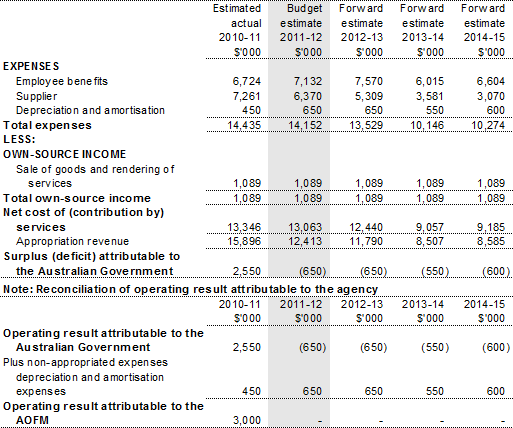
Prepared on Australian Accounting Standards basis.
Table 3.2.2: Budgeted departmental balance sheet
(as at 30 June)
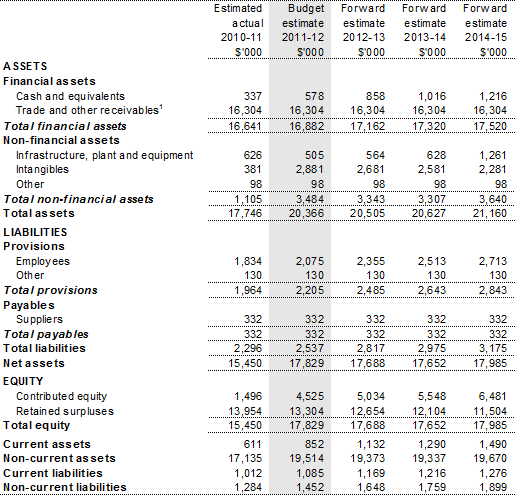
1. Includes undrawn appropriations of $16.1 million.
Prepared on Australian Accounting Standards basis.
Table 3.2.3: Budgeted departmental statement of cash flows
(for the period ended 30 June)
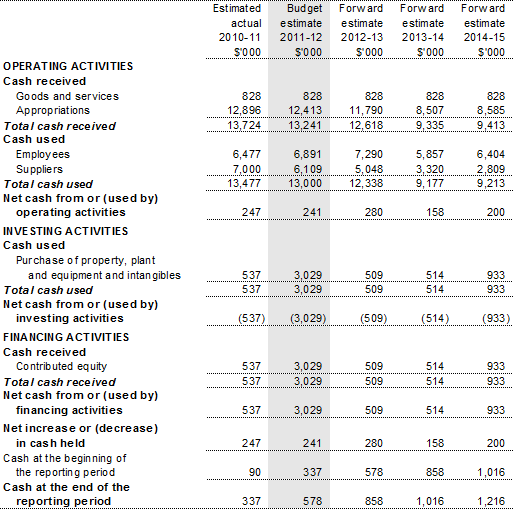
Prepared on Australian Accounting Standards basis.
Table 3.2.4: Departmental statement of changes in equity — summary of movement
(budget year 2011-12)
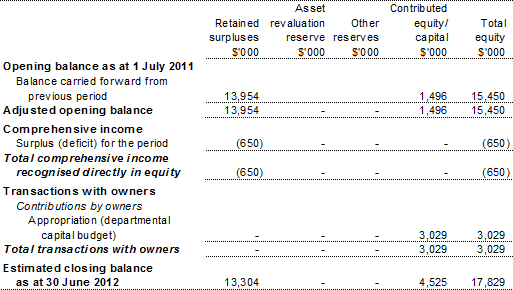
Prepared on Australian Accounting Standards basis.
Table 3.2.5: Departmental capital budget (DCB) statement
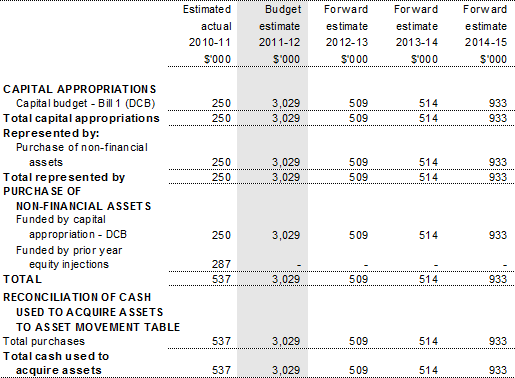
Prepared on Australian Accounting Standards basis.
Table 3.2.6: Statement of asset movements — depart
mental
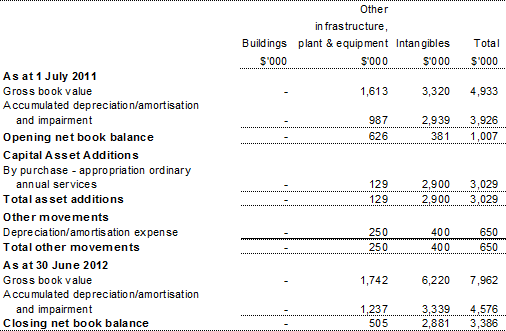
Prepared on Australian Accounting Standards basis.
Table 3.2.7: Schedule of budgeted income and expenses administered on behalf of
government (for the period ended 30 June)
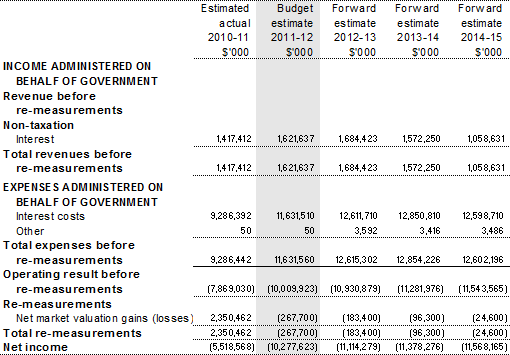
Prepared on Australian Accounting Standards basis.
Table 3.2.8: Schedule of budgeted assets and liabilities administered on behalf of
government (as at 30 June)
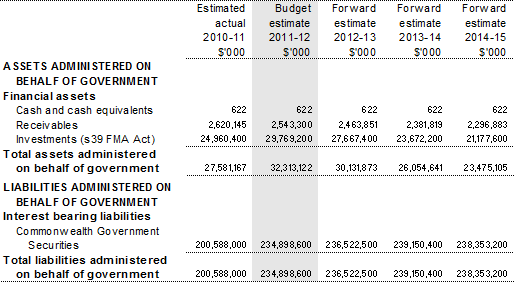
Prepared on Australian Accounting Standards basis.
Table 3.2.9: Schedule of budgeted administered cash flows
(for the period ended 30 June)
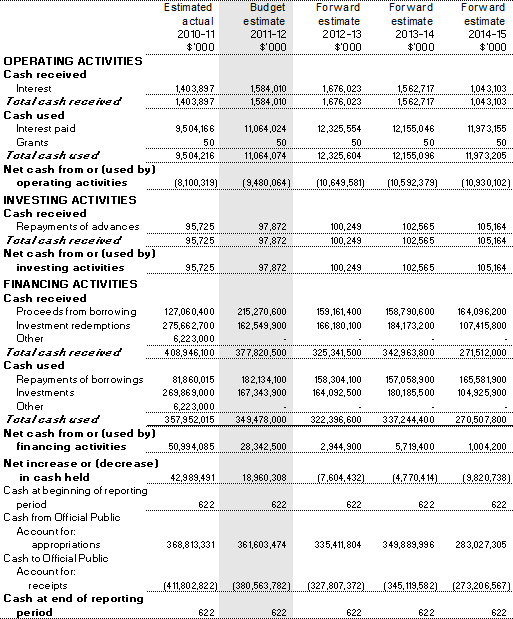
Prepared on Australian Accounting Standards basis.
Table 3.2.10: Schedule of administered capital budget
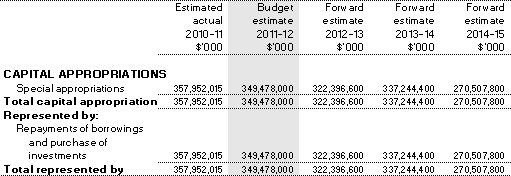
Prepared on Australian Accounting Standards basis.
3.2.4 Notes to the financial statements
The financial statements contain estimates prepared in accordance with the requirements of the Australian Government's financial budgeting and reporting framework, including Australian Accounting Standards and Statements of Accounting Concepts, as well as specific guidelines issued by the Department of Finance and Deregulation.
The departmental financial statements have been prepared in accordance with the historical cost convention, except for infrastructure, plant and equipment assets and employee entitlements.
With exception to loans to the States and the Northern Territory, the administered financial statements have been prepared on a fair value basis in accordance with Australian Accounting Standards. Loans to the States and the Northern Territory are measured on an amortised cost basis, after initial recognition at fair value.
Fair value is synonymous with market value and represents the estimated exchange equivalent price using relevant inputs from reference markets and valuation techniques. Fair value is determined on the presumption of normal market conditions and that the reporting entity is not undertaking transactions on adverse terms.
Budgeted departmental and administered financial statements
Under the Australian Government's accrual budgeting framework, transactions that agencies control (agency transactions) are separately budgeted for and reported from transactions agencies do not have control over (administered transactions). This ensures that agencies are only held fully accountable for the transactions over which they have control.
Agency assets, liabilities, revenue and expenses are those which are controlled by the agency. Agency expenses include employee and supplier expenses and other administrative costs, which are incurred by the agency in providing its goods and services to government.
Administered assets, liabilities, revenues and expenses are those which are managed on behalf of the Australian Government according to set government directions. Administered expenses include interest incurred on Commonwealth Government Securities. Administered revenues include interest earned on housing agreement loans and interest on investments (including residential mortgage-backed securities).
Administered internal transactions
Administered transactions between the AOFM and other agencies within the general government sector (administered internal transactions) are not reported in the schedule of budgeted administered income and expenses or the schedule of budgeted administered assets and liabilities.
However, for the purposes of disclosing all cash flows through the AOFM's administered bank accounts, cash flows in the schedule of budgeted administered cash flows are reported inclusive of administered internal transactions.
Goods and services tax
Supplies provided by the AOFM are predominantly input taxed under A New Tax System (Goods and Services Tax) Act 1999.
Budgeted departmental comprehensive income statement
Appropriations
Under the net cash appropriation framework the AOFM receives an output appropriation to meet budgeted expenses (except depreciation). The output appropriation is recognised in revenue. Appropriations for capital purposes are not recognised in revenue.
Budgeted departmental balance sheet
Cash and undrawn appropriations
The estimated cash reserves and undrawn appropriations will be maintained to ensure that the AOFM is well placed to:
- settle employee liabilities as they fall due;
- fund future asset replacements; and
- repay liabilities.
Administered schedule of budgeted income and expenses
Non-taxation revenue — interest

Expenses — interest costs

Net market valuation gains (losses)
Net market valuation gains (losses) represent the estimated unrealised fair value gains or losses on the financial asset and financial liability portfolio. This revaluation effect represents the change in financial exposures due to changes in market conditions and the passage of time.
In a passive 'issue and hold to maturity' strategy, such as that relating to the AOFM's debt issuance and management activities, the revaluation effect will net to zero over the life of a financial instrument.
Administered schedule of budgeted assets and liabilities
Financial assets — investments
The AOFM manages the cash balances in the Official Public Account and invests surplus funds in deposits, fixed interest securities and money market securities. Estimates of the fair value of these asset holdings are disclosed as administered investments. The asset holdings of the Future Fund and other government agencies are not included in these estimates.
Investments also include residential mortgage-backed securities.
Interest bearing liabilities — Commonwealth Government Securities
Interest bearing liabilities represent the fair value of Commonwealth Government Securities on issue.
